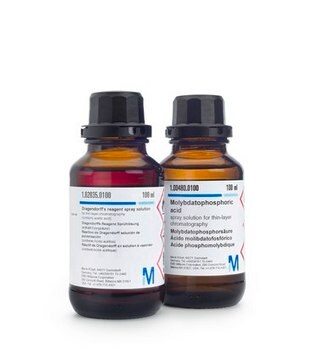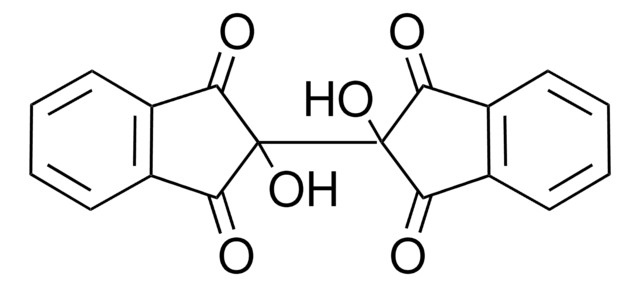推薦產品
等級
for TLC derivatization
品質等級
形狀
liquid
技術
thin layer chromatography (TLC): suitable
雜質
1-butanol
acetic acid
密度
0.823 g/mL at 20 °C
一般說明
Ninhydrin reagent is mostly used for the detection of amino acids. It basically gives a characteristic purple color on reaction with a-amino acids and other amino compounds, provided the pH of the reaction is 5.0 or higher. At an acid pH of 0.3, the reaction of ninhydrin with ornithinine and proline results in a red color product. Ninhydrin reagent can stay stable at room temperature in the absence of nitrogen atmosphere for upto 1 month in the ethylene glycol-sodium acetate solvent system.
應用
1 g ninhydrin dissolved in 475 mL 1-butanol and 25 mL acetic acid
Ninhydrin reagent may be used for the quantitative determination of total protein content in tissue hydrolysates.
訊號詞
Danger
危險分類
Acute Tox. 4 Oral - Eye Dam. 1 - Flam. Liq. 3 - Skin Irrit. 2 - STOT SE 3
標靶器官
Central nervous system, Respiratory system
儲存類別代碼
3 - Flammable liquids
水污染物質分類(WGK)
WGK 2
閃點(°F)
93.2 °F - closed cup
閃點(°C)
34 °C - closed cup
個人防護裝備
Faceshields, Gloves, Goggles, type ABEK (EN14387) respirator filter
客戶也查看了
B Starcher
Analytical biochemistry, 292(1), 125-129 (2001-04-26)
Quantitation of small tissue samples for total protein content is essential for many biochemical analyses. In this study a ninhydrin method for measuring the total protein content of tissue hydrolysates is presented. The ninhydrin reagent is stable at room temperature
M K Gaitonde
The Biochemical journal, 104(2), 627-633 (1967-08-01)
1. An acid ninhydrin reagent was found to react specifically in forming a pink product (E(max.) 560mmu) with cysteine. 2. The method was highly sensitive for the determination of cysteine (in 28.0x10(3)). Homocysteine, glutathione, proline, ornithine and other naturally occurring
Sylvia Kristyanto et al.
Journal of microbiology (Seoul, Korea), 56(5), 317-323 (2018-05-04)
A novel, aerobic, Gram-stain-negative, non-motile, non-spore forming, rod-shaped bacterium, designated strain Dol 15-39T, was isolated from a seawater sample near Geoje Island in the South Sea, Republic of Korea. The strain was found to be oxidase-negative and catalase-positive. The isolate
Thin Layer Chromatography in Phytochemistry.
Hajnos WM
Science, 312-312 (2008)
我們的科學家團隊在所有研究領域都有豐富的經驗,包括生命科學、材料科學、化學合成、色譜、分析等.
聯絡技術服務














